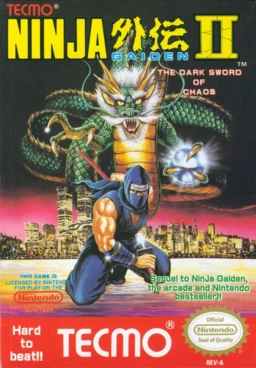Ninja Gaiden 2 - The Dark Sword Of Chaos
20
Compartir Contenido en Redes Sociales
game Details
Ninja Gaiden II: The Dark Sword of Chaos
For the modern title, see Ninja Gaiden II.
Ninja Gaiden II: The Dark Sword of Chaos, known in Japan as Ninja Ryūkenden II: Ankoku no Jashinken (忍者龍剣伝 II 暗黒の邪神剣 lit. Legend of the Ninja Dragon Sword II: The Demonic Sword of Darkness?) and as Shadow Warriors 2 in the PAL region, is the second instalment in the trilogy for the Nintendo Entertainment System. A licensed port was later released for DOS-based PCs and Commodore Amiga. It was released on the Wii Virtual Console on October 15 in North America.
Contents
[show]
Gameplay
Ninja Gaiden II features the same platformer gameplay as its predecessor, with some extra additions.
Ryu retains his various projectile attacks which consume ninja power:
- Throwing Star (5 points) - the most basic shuriken attack
- Windmill Throwing Star (10 points) - acting as a boomerang, this star flies back and forth across the screen, taking out enemies until returned to Ryu
- The Art of the Fire Wheel (8 points) - tosses a wheel of fire at enemies
- Fire Dragon Balls (8 points) - fires dragon balls below the player at a 45 degree angle
- Invincible Fire Wheel (15 points) - a circling version of the Fire Wheel which renders Ryu invincible. Unlike in the previous game, the wheel can be called at will.
New to this sequel:
- In this episode, Ryu has the power to climb any wall by pressing Up or Down on the control pad. In the previous game, the player could only "stick" to a wall by jumping towards it, but was unable to scale in any direction without jumping to an opposite wall or by using a climbing technique that involved jumping away from the wall and immediately grasping it again.
- The most innovative new feature was the ability to create "split clones" (also referred to as "Phantom Doubles" or "Shadow Clones") where by picking up an item, an orange shadow version of Ryu would constantly follow him, and attack at the same time as Ryu. These clones were immune to damage, and enemies and projectiles would pass through them. If the player stopped moving, the clones would be frozen, regardless of position, being in mid-air or between enemies or objects. In the still phase, the clones performed the projectile or slash attacks of the player. Up to two split clones could be used at any given time. In the adjacent screenshot, the player has jumped to the left of the enemy, while his spirit clone remains in mid-air in Ryu's previous position. Frozen in place, the clone copies the attacks of the player.
- The only game in the original trilogy to have titles to its music tracks. The music played during Stage 3-2, titled The Parasprinter, is, to date, the most remixed Ninja Gaiden BGM.
- For its time, Ninja Gaiden II featured a striking amount of blood and violence, especially considering Nintendo's practice of censorship at the time. Such scenes include the graphic depiction of the dripping blood on Ashtar's sword, the pool of blood expanding from Jaquio, and frequent use of realistic firearms.
- Of all three games in the trilogy, Ninja Gaiden II was the most censored of the three in the SNES compilation. Among them, Jaquio's pool of blood was changed from red to green, and the hexagram on his cloak was edited to look like nothing at all.
of
no
katana
nes
the
gameplay
longplay
walkthrough
playthrough
Nintendo Entertainment System (Computer)
full
Video Game (Industry)
Let's Play
death
8-bit
Ninja Gaiden II: The Dark Sword Of Chaos
Ninja Gaiden (Video Game Series)
Warriors
ninja
gaiden
two
dark
sword
chaos
Tecmo Koei (Business Operation)
Operation (Game)
ryu
hayabusa
samurai
jacquio
Ashtar
platforming
shuriken
Ninja Gaiden II (Video Game)
Dando the Cursed
Baron Spider
Funky Dynamite
Naga Sotuva


